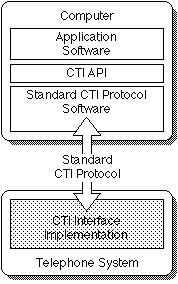Third Phase of CTI Evolution CTI Protocols for Systems, | ||
| While the second phase was characterized by its focus on the needs of application developers, the third phase in the evolution of CTI is characterized by its focus on the needs of telephone system vendors and customers. It involves improving on phase two by addressing the reliability issues and eliminating the key bottleneck, that is, the effort required by telephone system vendors to implement and maintain all the different APIs for all the different operating systems. Both of these objectives are accomplished through the addition of standardized CTI protocols to the APIs developed during phase two. In the third phase, telephone system vendors are responsible only for implementing software that runs internally on their own products. The only interaction with application software is through standardized CTI protocols. This is illustrated below. | |||||
 | ||||||
The result is that telephone system vendors no longer have to be concerned with how many operating systems they support and which operating systems their customers are using. This also allows their telephony products to be used by devices that don'st even have operating systems (or CTI APIs in the conventional sense). Freeing up their resources from platform-specific development projects allows telephone system vendors to focus on providing richer functionality and more robust operation. The benefit for customers and application developers is that the normalized protocols provide a much higher level of reliability and robustness using the existing operating system-based APIs. Application developers don't have to "special-case" specific telephone systems (unless they want to take advantage of special and unique features) and customers then can use applications without having to worry about compatibility. | ||||||
© Copyright 1996-2004 For more information, contact Michael Bayer at Computer Telephony Solutions | |